Access, Cost, and Quality for Advanced Practice Nurse Report
VerifiedAdded on 2022/11/01
|8
|1641
|473
Report
AI Summary
This report examines the evolving role of Advanced Practice Nurses (APNs) in the U.S. healthcare system, emphasizing cost-effectiveness and quality patient care. It highlights the importance of healthy work environments for nurses, efficient staffing, and the impact of stress on job satisfaction and turnover rates. The report details quality improvement initiatives, including patient-centered care, efficient communication, and initiatives by organizations like the Institute of Medicine and the American Nurses Association. It emphasizes the shift towards APNs for improved patient communication and performance evaluation. Outcome measurement is discussed as a critical component of assessing interventions, with a focus on nurse-sensitive approaches and the impact of working environments on patient and nurse outcomes. The report concludes by advocating for initiatives that enhance quality healthcare while considering costs, with physicians and APNs at the forefront of implementation. The report includes references to support the findings and recommendations.
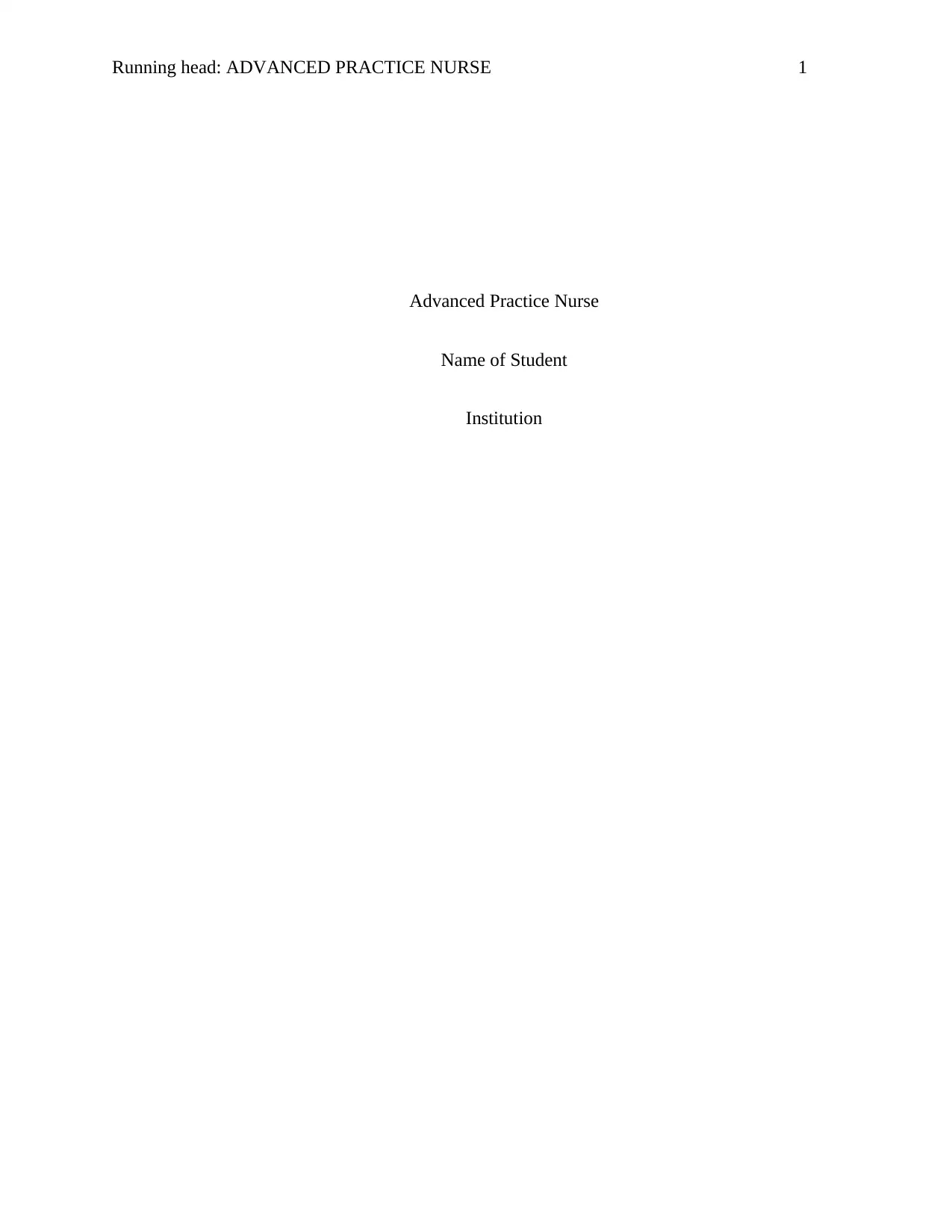
Running head: ADVANCED PRACTICE NURSE 1
Advanced Practice Nurse
Name of Student
Institution
Advanced Practice Nurse
Name of Student
Institution
Paraphrase This Document
Need a fresh take? Get an instant paraphrase of this document with our AI Paraphraser
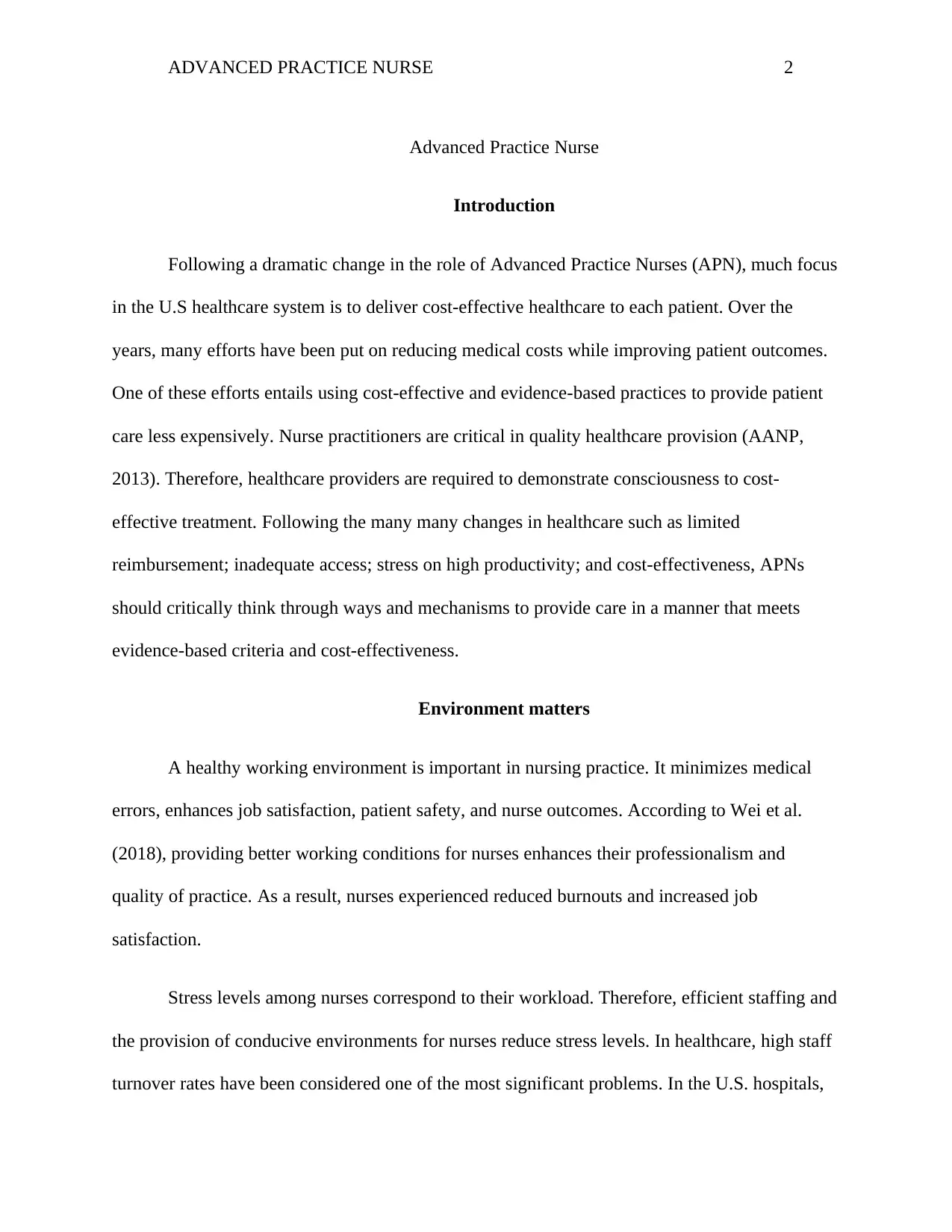
ADVANCED PRACTICE NURSE 2
Advanced Practice Nurse
Introduction
Following a dramatic change in the role of Advanced Practice Nurses (APN), much focus
in the U.S healthcare system is to deliver cost-effective healthcare to each patient. Over the
years, many efforts have been put on reducing medical costs while improving patient outcomes.
One of these efforts entails using cost-effective and evidence-based practices to provide patient
care less expensively. Nurse practitioners are critical in quality healthcare provision (AANP,
2013). Therefore, healthcare providers are required to demonstrate consciousness to cost-
effective treatment. Following the many many changes in healthcare such as limited
reimbursement; inadequate access; stress on high productivity; and cost-effectiveness, APNs
should critically think through ways and mechanisms to provide care in a manner that meets
evidence-based criteria and cost-effectiveness.
Environment matters
A healthy working environment is important in nursing practice. It minimizes medical
errors, enhances job satisfaction, patient safety, and nurse outcomes. According to Wei et al.
(2018), providing better working conditions for nurses enhances their professionalism and
quality of practice. As a result, nurses experienced reduced burnouts and increased job
satisfaction.
Stress levels among nurses correspond to their workload. Therefore, efficient staffing and
the provision of conducive environments for nurses reduce stress levels. In healthcare, high staff
turnover rates have been considered one of the most significant problems. In the U.S. hospitals,
Advanced Practice Nurse
Introduction
Following a dramatic change in the role of Advanced Practice Nurses (APN), much focus
in the U.S healthcare system is to deliver cost-effective healthcare to each patient. Over the
years, many efforts have been put on reducing medical costs while improving patient outcomes.
One of these efforts entails using cost-effective and evidence-based practices to provide patient
care less expensively. Nurse practitioners are critical in quality healthcare provision (AANP,
2013). Therefore, healthcare providers are required to demonstrate consciousness to cost-
effective treatment. Following the many many changes in healthcare such as limited
reimbursement; inadequate access; stress on high productivity; and cost-effectiveness, APNs
should critically think through ways and mechanisms to provide care in a manner that meets
evidence-based criteria and cost-effectiveness.
Environment matters
A healthy working environment is important in nursing practice. It minimizes medical
errors, enhances job satisfaction, patient safety, and nurse outcomes. According to Wei et al.
(2018), providing better working conditions for nurses enhances their professionalism and
quality of practice. As a result, nurses experienced reduced burnouts and increased job
satisfaction.
Stress levels among nurses correspond to their workload. Therefore, efficient staffing and
the provision of conducive environments for nurses reduce stress levels. In healthcare, high staff
turnover rates have been considered one of the most significant problems. In the U.S. hospitals,
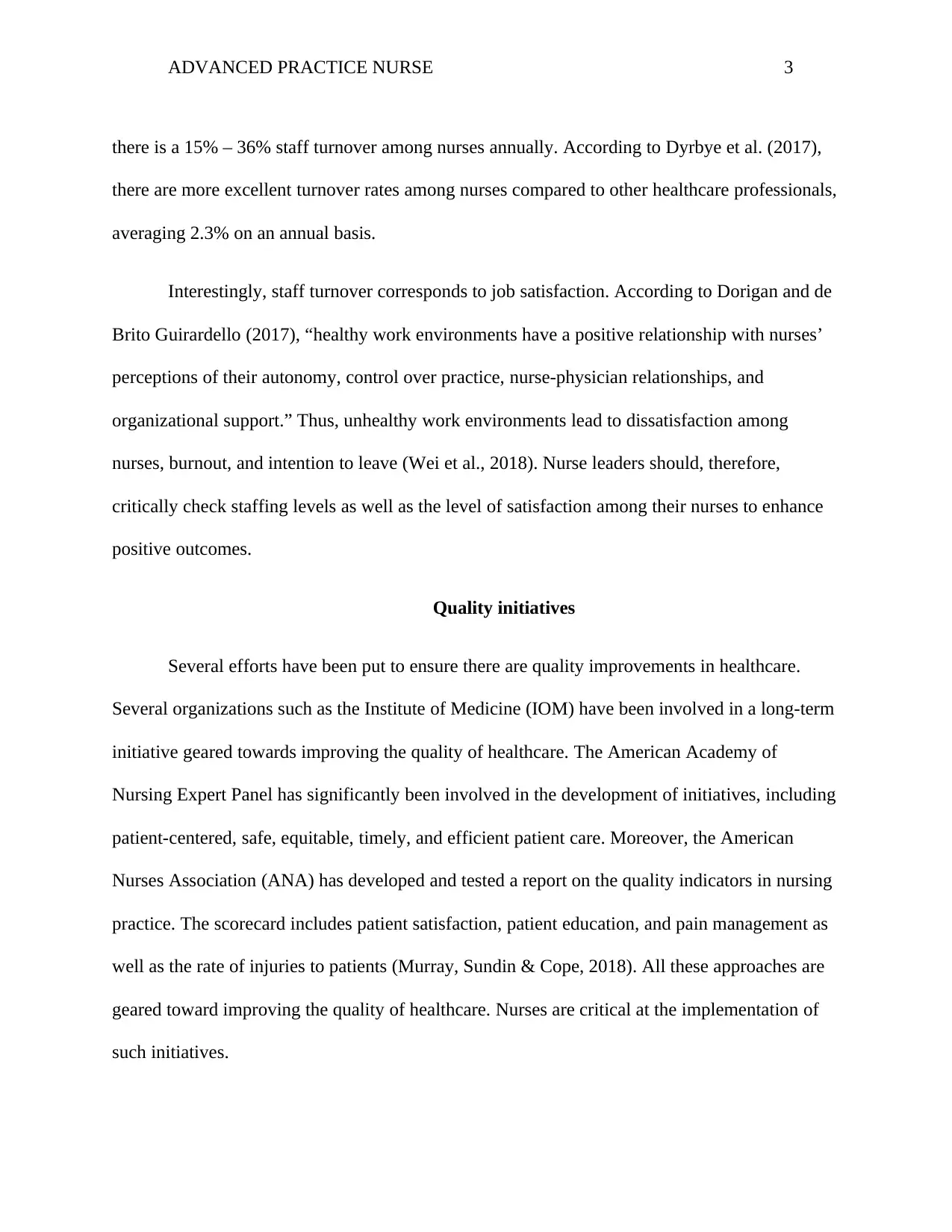
ADVANCED PRACTICE NURSE 3
there is a 15% – 36% staff turnover among nurses annually. According to Dyrbye et al. (2017),
there are more excellent turnover rates among nurses compared to other healthcare professionals,
averaging 2.3% on an annual basis.
Interestingly, staff turnover corresponds to job satisfaction. According to Dorigan and de
Brito Guirardello (2017), “healthy work environments have a positive relationship with nurses’
perceptions of their autonomy, control over practice, nurse-physician relationships, and
organizational support.” Thus, unhealthy work environments lead to dissatisfaction among
nurses, burnout, and intention to leave (Wei et al., 2018). Nurse leaders should, therefore,
critically check staffing levels as well as the level of satisfaction among their nurses to enhance
positive outcomes.
Quality initiatives
Several efforts have been put to ensure there are quality improvements in healthcare.
Several organizations such as the Institute of Medicine (IOM) have been involved in a long-term
initiative geared towards improving the quality of healthcare. The American Academy of
Nursing Expert Panel has significantly been involved in the development of initiatives, including
patient-centered, safe, equitable, timely, and efficient patient care. Moreover, the American
Nurses Association (ANA) has developed and tested a report on the quality indicators in nursing
practice. The scorecard includes patient satisfaction, patient education, and pain management as
well as the rate of injuries to patients (Murray, Sundin & Cope, 2018). All these approaches are
geared toward improving the quality of healthcare. Nurses are critical at the implementation of
such initiatives.
there is a 15% – 36% staff turnover among nurses annually. According to Dyrbye et al. (2017),
there are more excellent turnover rates among nurses compared to other healthcare professionals,
averaging 2.3% on an annual basis.
Interestingly, staff turnover corresponds to job satisfaction. According to Dorigan and de
Brito Guirardello (2017), “healthy work environments have a positive relationship with nurses’
perceptions of their autonomy, control over practice, nurse-physician relationships, and
organizational support.” Thus, unhealthy work environments lead to dissatisfaction among
nurses, burnout, and intention to leave (Wei et al., 2018). Nurse leaders should, therefore,
critically check staffing levels as well as the level of satisfaction among their nurses to enhance
positive outcomes.
Quality initiatives
Several efforts have been put to ensure there are quality improvements in healthcare.
Several organizations such as the Institute of Medicine (IOM) have been involved in a long-term
initiative geared towards improving the quality of healthcare. The American Academy of
Nursing Expert Panel has significantly been involved in the development of initiatives, including
patient-centered, safe, equitable, timely, and efficient patient care. Moreover, the American
Nurses Association (ANA) has developed and tested a report on the quality indicators in nursing
practice. The scorecard includes patient satisfaction, patient education, and pain management as
well as the rate of injuries to patients (Murray, Sundin & Cope, 2018). All these approaches are
geared toward improving the quality of healthcare. Nurses are critical at the implementation of
such initiatives.
⊘ This is a preview!⊘
Do you want full access?
Subscribe today to unlock all pages.

Trusted by 1+ million students worldwide
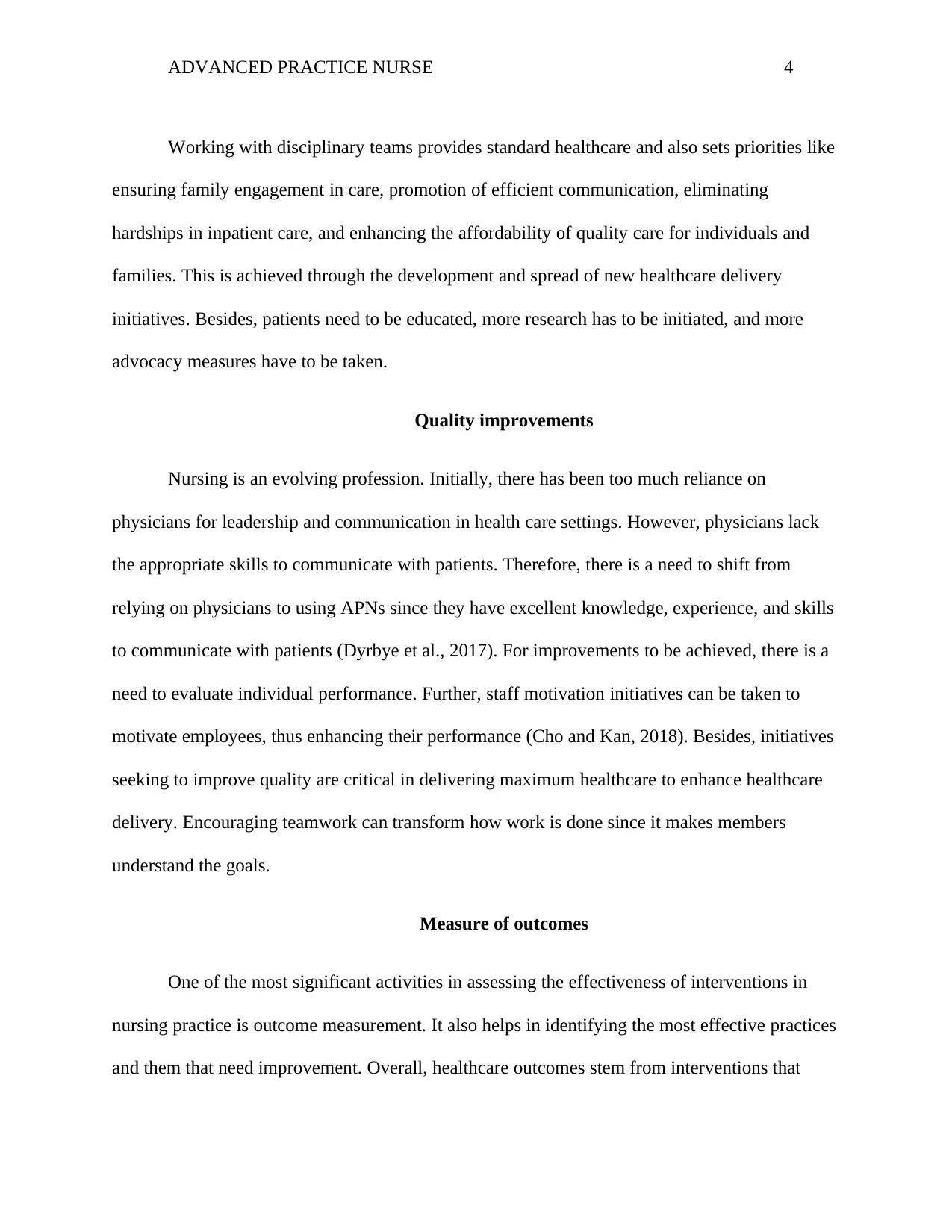
ADVANCED PRACTICE NURSE 4
Working with disciplinary teams provides standard healthcare and also sets priorities like
ensuring family engagement in care, promotion of efficient communication, eliminating
hardships in inpatient care, and enhancing the affordability of quality care for individuals and
families. This is achieved through the development and spread of new healthcare delivery
initiatives. Besides, patients need to be educated, more research has to be initiated, and more
advocacy measures have to be taken.
Quality improvements
Nursing is an evolving profession. Initially, there has been too much reliance on
physicians for leadership and communication in health care settings. However, physicians lack
the appropriate skills to communicate with patients. Therefore, there is a need to shift from
relying on physicians to using APNs since they have excellent knowledge, experience, and skills
to communicate with patients (Dyrbye et al., 2017). For improvements to be achieved, there is a
need to evaluate individual performance. Further, staff motivation initiatives can be taken to
motivate employees, thus enhancing their performance (Cho and Kan, 2018). Besides, initiatives
seeking to improve quality are critical in delivering maximum healthcare to enhance healthcare
delivery. Encouraging teamwork can transform how work is done since it makes members
understand the goals.
Measure of outcomes
One of the most significant activities in assessing the effectiveness of interventions in
nursing practice is outcome measurement. It also helps in identifying the most effective practices
and them that need improvement. Overall, healthcare outcomes stem from interventions that
Working with disciplinary teams provides standard healthcare and also sets priorities like
ensuring family engagement in care, promotion of efficient communication, eliminating
hardships in inpatient care, and enhancing the affordability of quality care for individuals and
families. This is achieved through the development and spread of new healthcare delivery
initiatives. Besides, patients need to be educated, more research has to be initiated, and more
advocacy measures have to be taken.
Quality improvements
Nursing is an evolving profession. Initially, there has been too much reliance on
physicians for leadership and communication in health care settings. However, physicians lack
the appropriate skills to communicate with patients. Therefore, there is a need to shift from
relying on physicians to using APNs since they have excellent knowledge, experience, and skills
to communicate with patients (Dyrbye et al., 2017). For improvements to be achieved, there is a
need to evaluate individual performance. Further, staff motivation initiatives can be taken to
motivate employees, thus enhancing their performance (Cho and Kan, 2018). Besides, initiatives
seeking to improve quality are critical in delivering maximum healthcare to enhance healthcare
delivery. Encouraging teamwork can transform how work is done since it makes members
understand the goals.
Measure of outcomes
One of the most significant activities in assessing the effectiveness of interventions in
nursing practice is outcome measurement. It also helps in identifying the most effective practices
and them that need improvement. Overall, healthcare outcomes stem from interventions that
Paraphrase This Document
Need a fresh take? Get an instant paraphrase of this document with our AI Paraphraser
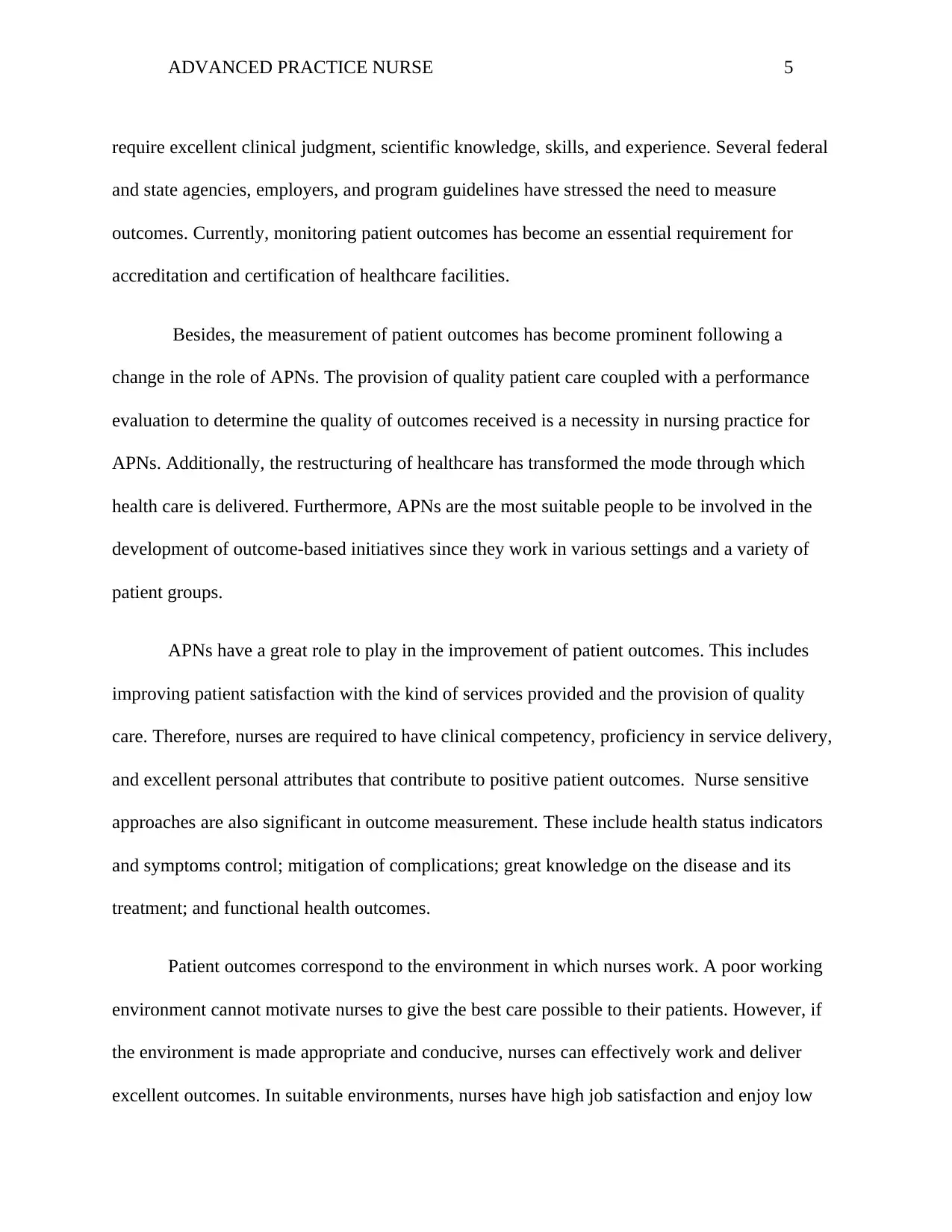
ADVANCED PRACTICE NURSE 5
require excellent clinical judgment, scientific knowledge, skills, and experience. Several federal
and state agencies, employers, and program guidelines have stressed the need to measure
outcomes. Currently, monitoring patient outcomes has become an essential requirement for
accreditation and certification of healthcare facilities.
Besides, the measurement of patient outcomes has become prominent following a
change in the role of APNs. The provision of quality patient care coupled with a performance
evaluation to determine the quality of outcomes received is a necessity in nursing practice for
APNs. Additionally, the restructuring of healthcare has transformed the mode through which
health care is delivered. Furthermore, APNs are the most suitable people to be involved in the
development of outcome-based initiatives since they work in various settings and a variety of
patient groups.
APNs have a great role to play in the improvement of patient outcomes. This includes
improving patient satisfaction with the kind of services provided and the provision of quality
care. Therefore, nurses are required to have clinical competency, proficiency in service delivery,
and excellent personal attributes that contribute to positive patient outcomes. Nurse sensitive
approaches are also significant in outcome measurement. These include health status indicators
and symptoms control; mitigation of complications; great knowledge on the disease and its
treatment; and functional health outcomes.
Patient outcomes correspond to the environment in which nurses work. A poor working
environment cannot motivate nurses to give the best care possible to their patients. However, if
the environment is made appropriate and conducive, nurses can effectively work and deliver
excellent outcomes. In suitable environments, nurses have high job satisfaction and enjoy low
require excellent clinical judgment, scientific knowledge, skills, and experience. Several federal
and state agencies, employers, and program guidelines have stressed the need to measure
outcomes. Currently, monitoring patient outcomes has become an essential requirement for
accreditation and certification of healthcare facilities.
Besides, the measurement of patient outcomes has become prominent following a
change in the role of APNs. The provision of quality patient care coupled with a performance
evaluation to determine the quality of outcomes received is a necessity in nursing practice for
APNs. Additionally, the restructuring of healthcare has transformed the mode through which
health care is delivered. Furthermore, APNs are the most suitable people to be involved in the
development of outcome-based initiatives since they work in various settings and a variety of
patient groups.
APNs have a great role to play in the improvement of patient outcomes. This includes
improving patient satisfaction with the kind of services provided and the provision of quality
care. Therefore, nurses are required to have clinical competency, proficiency in service delivery,
and excellent personal attributes that contribute to positive patient outcomes. Nurse sensitive
approaches are also significant in outcome measurement. These include health status indicators
and symptoms control; mitigation of complications; great knowledge on the disease and its
treatment; and functional health outcomes.
Patient outcomes correspond to the environment in which nurses work. A poor working
environment cannot motivate nurses to give the best care possible to their patients. However, if
the environment is made appropriate and conducive, nurses can effectively work and deliver
excellent outcomes. In suitable environments, nurses have high job satisfaction and enjoy low
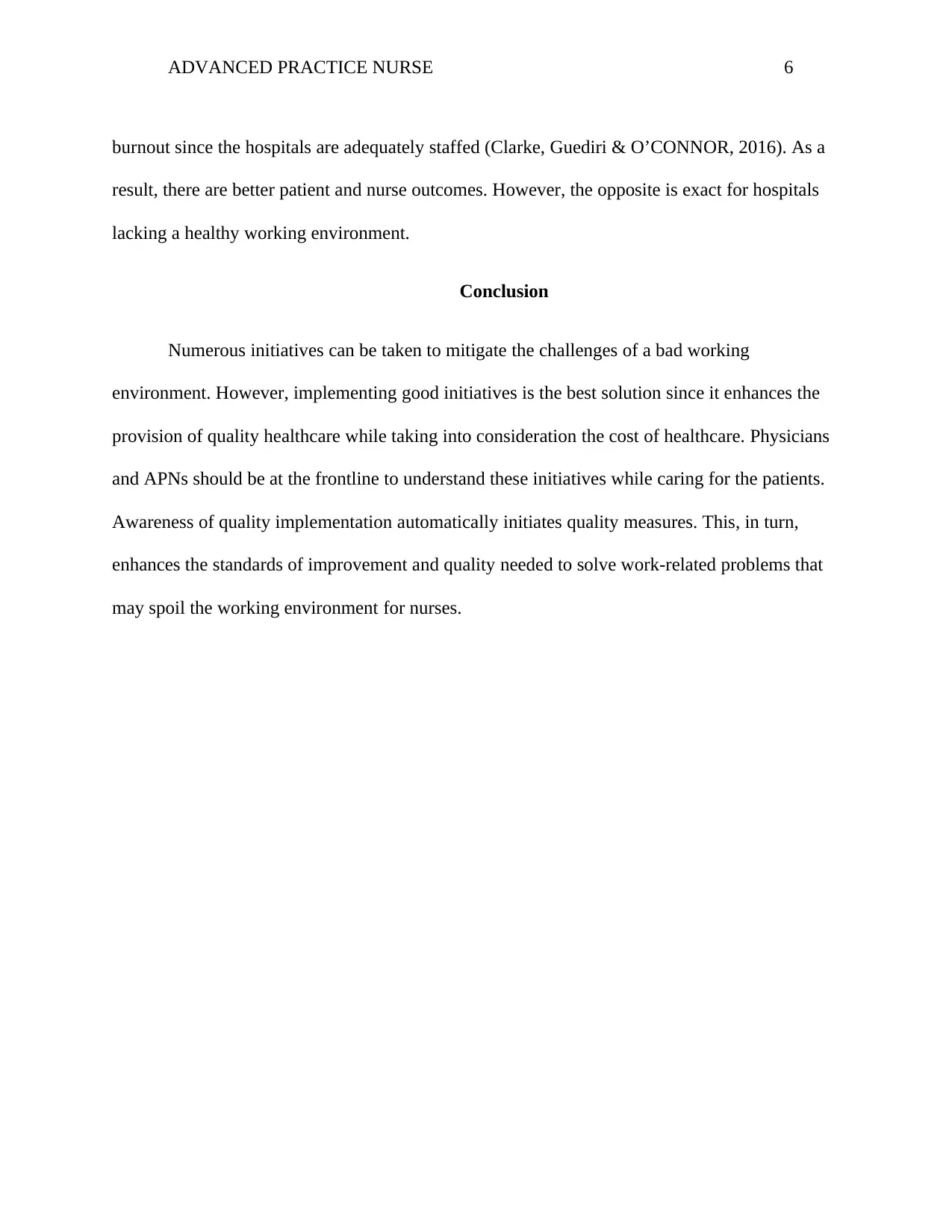
ADVANCED PRACTICE NURSE 6
burnout since the hospitals are adequately staffed (Clarke, Guediri & O’CONNOR, 2016). As a
result, there are better patient and nurse outcomes. However, the opposite is exact for hospitals
lacking a healthy working environment.
Conclusion
Numerous initiatives can be taken to mitigate the challenges of a bad working
environment. However, implementing good initiatives is the best solution since it enhances the
provision of quality healthcare while taking into consideration the cost of healthcare. Physicians
and APNs should be at the frontline to understand these initiatives while caring for the patients.
Awareness of quality implementation automatically initiates quality measures. This, in turn,
enhances the standards of improvement and quality needed to solve work-related problems that
may spoil the working environment for nurses.
burnout since the hospitals are adequately staffed (Clarke, Guediri & O’CONNOR, 2016). As a
result, there are better patient and nurse outcomes. However, the opposite is exact for hospitals
lacking a healthy working environment.
Conclusion
Numerous initiatives can be taken to mitigate the challenges of a bad working
environment. However, implementing good initiatives is the best solution since it enhances the
provision of quality healthcare while taking into consideration the cost of healthcare. Physicians
and APNs should be at the frontline to understand these initiatives while caring for the patients.
Awareness of quality implementation automatically initiates quality measures. This, in turn,
enhances the standards of improvement and quality needed to solve work-related problems that
may spoil the working environment for nurses.
⊘ This is a preview!⊘
Do you want full access?
Subscribe today to unlock all pages.

Trusted by 1+ million students worldwide
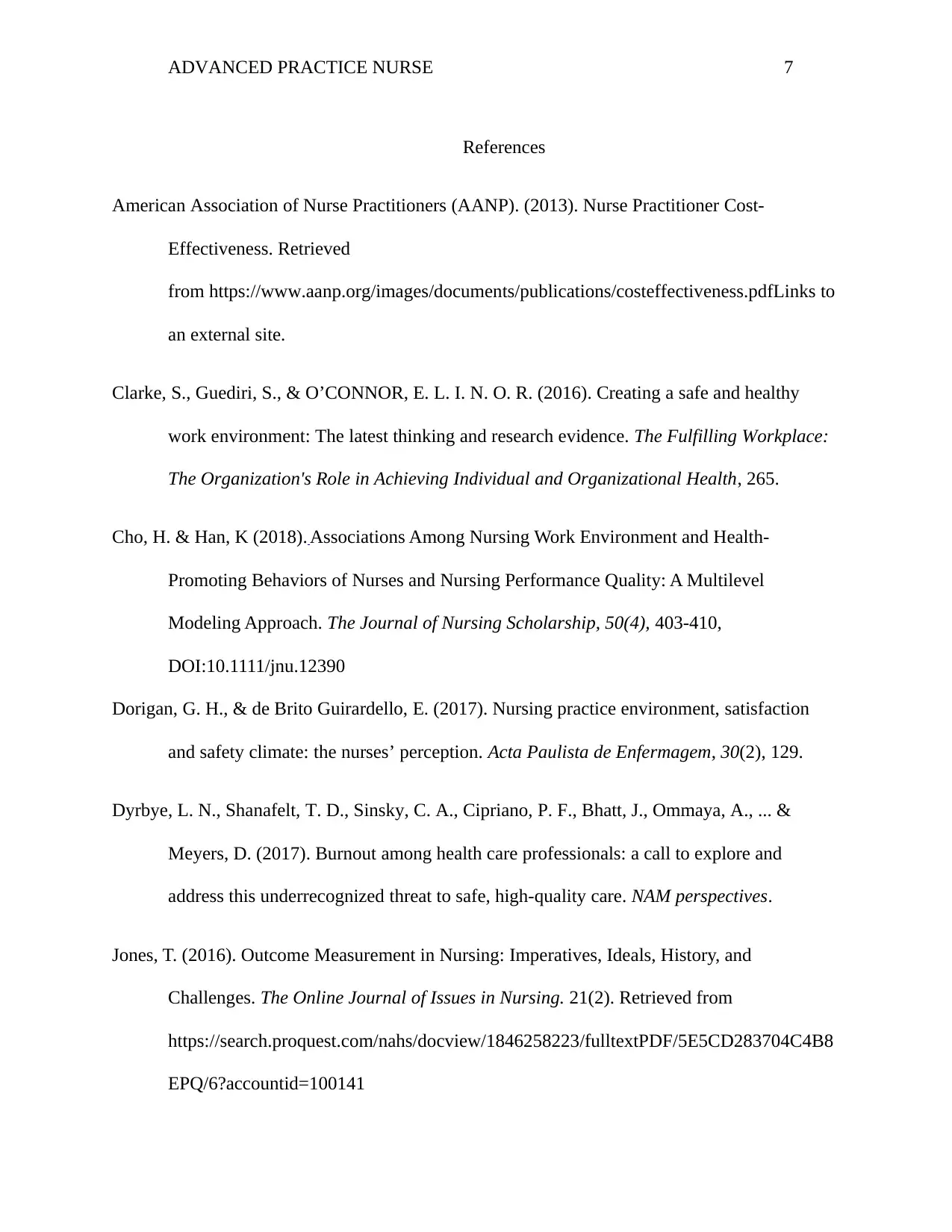
ADVANCED PRACTICE NURSE 7
References
American Association of Nurse Practitioners (AANP). (2013). Nurse Practitioner Cost-
Effectiveness. Retrieved
from https://www.aanp.org/images/documents/publications/costeffectiveness.pdfLinks to
an external site.
Clarke, S., Guediri, S., & O’CONNOR, E. L. I. N. O. R. (2016). Creating a safe and healthy
work environment: The latest thinking and research evidence. The Fulfilling Workplace:
The Organization's Role in Achieving Individual and Organizational Health, 265.
Cho, H. & Han, K (2018). Associations Among Nursing Work Environment and Health-
Promoting Behaviors of Nurses and Nursing Performance Quality: A Multilevel
Modeling Approach. The Journal of Nursing Scholarship, 50(4), 403-410,
DOI:10.1111/jnu.12390
Dorigan, G. H., & de Brito Guirardello, E. (2017). Nursing practice environment, satisfaction
and safety climate: the nurses’ perception. Acta Paulista de Enfermagem, 30(2), 129.
Dyrbye, L. N., Shanafelt, T. D., Sinsky, C. A., Cipriano, P. F., Bhatt, J., Ommaya, A., ... &
Meyers, D. (2017). Burnout among health care professionals: a call to explore and
address this underrecognized threat to safe, high-quality care. NAM perspectives.
Jones, T. (2016). Outcome Measurement in Nursing: Imperatives, Ideals, History, and
Challenges. The Online Journal of Issues in Nursing. 21(2). Retrieved from
https://search.proquest.com/nahs/docview/1846258223/fulltextPDF/5E5CD283704C4B8
EPQ/6?accountid=100141
References
American Association of Nurse Practitioners (AANP). (2013). Nurse Practitioner Cost-
Effectiveness. Retrieved
from https://www.aanp.org/images/documents/publications/costeffectiveness.pdfLinks to
an external site.
Clarke, S., Guediri, S., & O’CONNOR, E. L. I. N. O. R. (2016). Creating a safe and healthy
work environment: The latest thinking and research evidence. The Fulfilling Workplace:
The Organization's Role in Achieving Individual and Organizational Health, 265.
Cho, H. & Han, K (2018). Associations Among Nursing Work Environment and Health-
Promoting Behaviors of Nurses and Nursing Performance Quality: A Multilevel
Modeling Approach. The Journal of Nursing Scholarship, 50(4), 403-410,
DOI:10.1111/jnu.12390
Dorigan, G. H., & de Brito Guirardello, E. (2017). Nursing practice environment, satisfaction
and safety climate: the nurses’ perception. Acta Paulista de Enfermagem, 30(2), 129.
Dyrbye, L. N., Shanafelt, T. D., Sinsky, C. A., Cipriano, P. F., Bhatt, J., Ommaya, A., ... &
Meyers, D. (2017). Burnout among health care professionals: a call to explore and
address this underrecognized threat to safe, high-quality care. NAM perspectives.
Jones, T. (2016). Outcome Measurement in Nursing: Imperatives, Ideals, History, and
Challenges. The Online Journal of Issues in Nursing. 21(2). Retrieved from
https://search.proquest.com/nahs/docview/1846258223/fulltextPDF/5E5CD283704C4B8
EPQ/6?accountid=100141
Paraphrase This Document
Need a fresh take? Get an instant paraphrase of this document with our AI Paraphraser
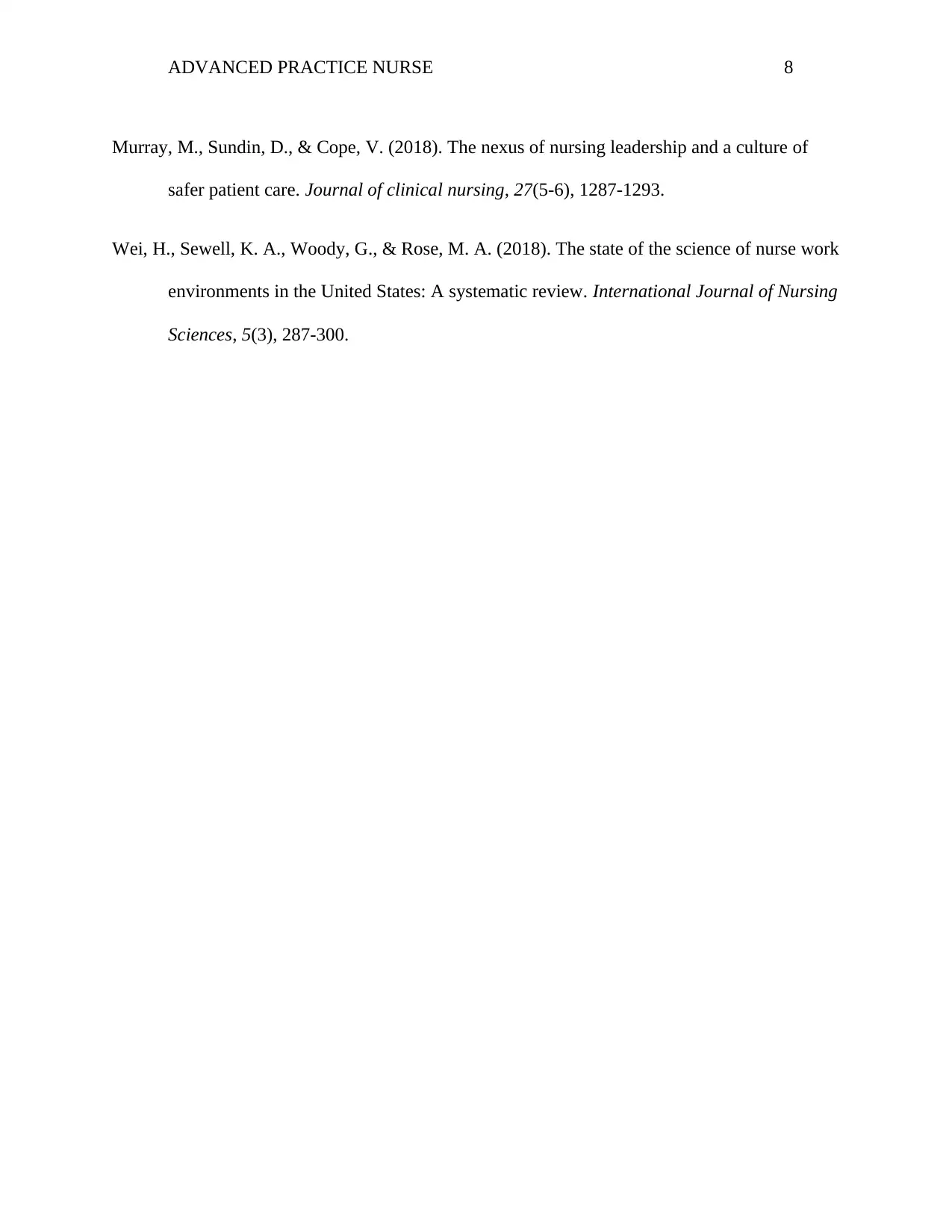
ADVANCED PRACTICE NURSE 8
Murray, M., Sundin, D., & Cope, V. (2018). The nexus of nursing leadership and a culture of
safer patient care. Journal of clinical nursing, 27(5-6), 1287-1293.
Wei, H., Sewell, K. A., Woody, G., & Rose, M. A. (2018). The state of the science of nurse work
environments in the United States: A systematic review. International Journal of Nursing
Sciences, 5(3), 287-300.
Murray, M., Sundin, D., & Cope, V. (2018). The nexus of nursing leadership and a culture of
safer patient care. Journal of clinical nursing, 27(5-6), 1287-1293.
Wei, H., Sewell, K. A., Woody, G., & Rose, M. A. (2018). The state of the science of nurse work
environments in the United States: A systematic review. International Journal of Nursing
Sciences, 5(3), 287-300.
1 out of 8
Related Documents
Your All-in-One AI-Powered Toolkit for Academic Success.
+13062052269
info@desklib.com
Available 24*7 on WhatsApp / Email
![[object Object]](/_next/static/media/star-bottom.7253800d.svg)
Unlock your academic potential
Copyright © 2020–2025 A2Z Services. All Rights Reserved. Developed and managed by ZUCOL.





